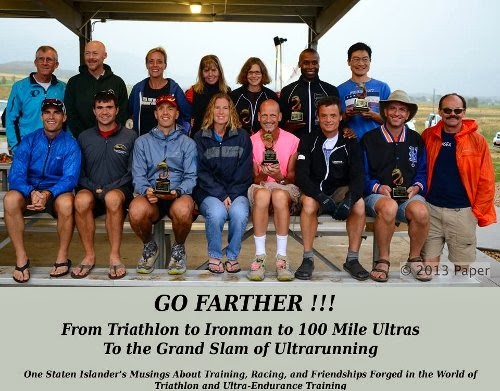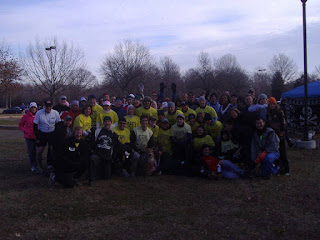I did it for the points!
😂
But I also found out the source of my recent ultra problems, and it's quite the doozy.
With my DNF at Grindstone I found myself lacking the UTMB points, and
the desire, to run other ultras, particularly 100 milers. I publicly
swore off ultras while while I was concentrating on making the podium at
triathlons.
But somehow in the back of my mind I was going to
want to attempt UTMB again, at least one more time, get to that finish
line, and put this race in my rear view mirror for the rest of my life.
The problem is getting in. Some ultras are "UTMB Points races", meaning
they register with the International Trail Running Association (ITRA).
The longest and most mountainous races are 6 points, flatter 100 milers
are 5 points, some 50 milers and 100k races are 4 points, etc. And UTMB
requires 15 of these points over 3 races in order to get into the
lottery.
These points expire after 2 years. So postponing this
race to a later date means I would have to race 3 ultras to gain all 15
points needed to get into the lottery.
A daunting task.
Looking at my present situation, however, I already have 11 points. I
received 6 points from Zion 100 last year and 5 points from Rocky
Raccoon 100 this year. And... I'm a second year entrant! I was rejected
last year, which means I get *two* ballots.That should give me a decent
75% chance to get in!
So all I needed was 4 points for the UTMB lottery.
Looking at the remaining qualifiers, the McDowell Mountain Frenzy 50 miler was the only race left to get those points.
But it's in Arizona. Can I take a quick trip out there, do the race, then come back? Do it on the cheap?
I found out it was quite feasible! So I decided to do it. One last attempt to qualify for UTMB.
I flew out the day before the race, and toed the starting line at 7AM. The race promptly started, and off I went!
The first few miles were awesome! I found running in the desert to be
such an experience! I did take note of the sunrise over the cacti as we
made our way North and west to the Sonoran preserve at mile 12. At some
point it became a steady gentle climb, so I backed off a little to
accommodate the ascent. I didn't care what time I came in; I just needed
those 4 points.
The 6 mile loop around the Sonoran Preserve was
quite strong. I got back to the 18 mile aid station in good shape. I
knew the next two stretches were the most difficult parts of the race,
so I decided to take the couple of extra minutes to hydrate and prepare
for those stretches.
The first difficult section was a long 10.5
mile section with some tough hills, according to my elevation charts.
The second difficult section was the 2.5 mile assault on Thompson Peak, a
2500 foot climb.
Going out into the 10.5 section, I was quite
methodical, but I knew the hills we're lurking in this section. I just
didn't know where. I got 6 miles into the stretch before we finally got
to the hills.
The hill turned out to be a heck of a climb, around 1000 feet.
I found myself in a lot of difficulty. The legs were getting heavy, the
breathing was getting labored, and all of a sudden I was having
negative thoughts.
"Here I go again", I thought.
With 2 miles to go in this section (26 miles in) I even thought of quitting. What was going on?
Then I discovered it.
Looking at my Garmin, I was discovering that I was going 10 min mile pace up a steep hill. What the...?
I realized that I was unconsciously sabotaging my race by justifying
the suffering by running too hard! I couldn't believe it! By pushing the
pace to an unreasonable level, my mind can then give the excuse to bow
out of the race and quit the suffering altogether.
This was a
stunning revelation. But I finally realized it. I immediately slowed
down the pace and forced myself to think in the present. I was no longer
looking at the 24 miles remaining in the race. I was only thinking
about the 2 miles I needed to get to the aid station. Then I can make
sound decisions there for the next section.
The running was
immediately bearable again. I promptly emerged from the trails to that
aid station. I was in need of nutrition and electrolytes.
And I
found that with the 2500 foot climb up to the top of Thompson Peak ahead
of me, now was a good time to take in a lot of food and drink. I was
going to be walking most of the way up; it was the perfect place to
digest a lot of food!
Thompson Peak - 2500 ft climb of pure suffering
Finally satisfied with my refueling, I
gazed at the mountain ahead of me and started my climb. I started pretty
slowly, making sure I was digesting my food. The climbs got a lot
steeper, but I started feeling a bit stronger. The climb was relentless;
it was Mt. Beacon on steroids! But I only stopped once, just to take a
picture of the fantastic scenery that was unfolding below me. I rounded
the final bend and got to the top.
A couple of guys were jotting
down the bib numbers at the top there. As they were writing my number
down I joked to them about every ultrarunner having this mountain in his
backyard. I turned around and headed back down the mountain again to
the aid station.
And I had new life!
At this point my mind
and my body were clicking as one, only focusing on the present, on the
ups and downs of the trails, on the task at hand. I got back to the
start/finish area at mile 42. We 50 milers just had an 8 mile section on
the "competitive loop" to go before we actually finish. I only took
about 2 minutes at the aid station before starting off in the last
section.
The only question was not "if" but "when" I was going to
finish. I was ticking off 11-12 minute miles and was wondering if I can
finish before the sun went down. I didn't want to reach into my pack to
get my headlamp. I got to mile 48.5 before I had to take it out.
In the shadows of dusk, I strongly finished the race at 10 hours 51
minutes. That was good for 37th place out of 105 people (99 finishers)
and 4th in my age group.
37th place overall, and my finisher's item for the race
And I got my 4 UTMB points
And
the best part is that I think I realized why I was having these recent
problems in ultras. In various ways, I was physically making it hard so
that my mind can justify withdrawing from the race. It almost happened
at Zion last year. It happened at Vermont 100 last year (by running
hard). It happened at Grindstone this year (purposely shuffling and
tripping over every rock to make the trails more difficult than they
seemed), and now this.
Now that I realize what is happening, I should be able to remedy this in future races when it pops up!
The mind is a fickle thing. It has to be on your side for it to be your
strongest Ally. For if it isn't, it can turn into your greatest enemy.
Overall course on my Garmin. It was a good race.





































